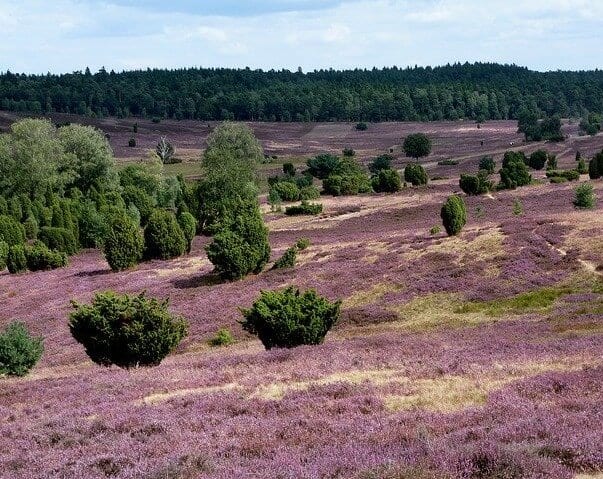If you want to enjoy and explore untouched nature in Germany, please look for a nature reserve or national park. Compared to landscape reserves and biosphere reserves, they offer the most pristine geology, flora and fauna.
Germany’s first nature reserve is the Neandertal and its largest is the Sylt Outer Reef with about 560,000 ha. When you are in a German nature reserve, there are very strict rules of conduct which may vary from state to state. For example, it may be forbidden to leave paths, to let dogs run free, to take stones, plants or insects, to camp or to frighten wildlife.
Besides these, there are many other rules when entering these areas – after all, the originality of nature should be protected. Therefore, inform yourself thoroughly beforehand, e.g. at the Federal Agency for Nature Conservation.
Table of content:
- Der Schwarzwald
- Der Harz
- Lüneburger Heide
- Sächsische Schweiz
- Jasmund
- Wattenmeer
- Teutoburger Wald
- Spreewald
1. Schwarzwald

The Black Forest is located in southern Germany / Baden-Württemberg and its largest city Freiburg. It is a heavily forested low mountain range whose highest mountain is the Feldberg with 1493m. With a good 6000km² area, it is Germany’s largest low mountain range.
Its well-known hiking trails such as Westweg, Mittelweg, Kandelhöhenweg or Murgleiter partly extend over several hundred kilometers. Its number of visitors in 2019 was close to 9 million people. Worth mentioning is also the cuckoo clock, which was developed here and is manufactured for worldwide export.
2. Harz

The Harz mountains, which are mostly located on the former territory of the GDR, have the Brocken as the highest mountain with 1142m. It is partly very rugged and wild with rustic streams. One finds primarily beech and spruce forests.
Hikers with a preference for hiking trails with steep climbs will feel at home here. The Brocken became famous, for example, because of the Brocken witches, who, according to popular belief, regularly gathered on the summit. But as a listening station of the eastern secret services in the GDR became a military exclusion zone.
3. Lüneburger Heide

The Lüneburg Heath now, in contrast to the previous two nature destinations, is a part of the Northern Plain of Germany. We find here moors, the heath and forests. The biggest elevation is the Wilseder Berg. There are also very long professional hiking trails here, such as the Heidschnuppenweg with 223km.
The 8000 year old Pietzmoor should be on your touring list. Also the Weseler Heide and the garrison town Lüneburg are worth a visit. I was stationed with the German Bundeswehr in Lüneburg from 2000 – 2001, I liked it there scenic extremely well!
4. Sächsische Schweiz

Under Saxon Switzerland we find the Saxon, German part of the Elbe Sandstone Mountains. Saxony is one of the few free states in Germany. The rugged rock formations are particularly striking. The Elbe Valley is especially beautiful seen from the Königsstein Fortress.
The Bastei Bridge and Bastei, a viewing platform is also a must on the destination list. Saxon Switzerland is one of the most popular hiking areas in Germany. So also Goethe hiked here and was in Altenberg in 1813. Here you just have to let the pictures speak for themselves!
5. Jasmund

The smallest national park in Germany is located far to the north on the island of Rügen. The main attraction are the chalk cliffs with the Königsstuhl. The beech forests located on the chalk cliffs are UNESCO World Heritage Sites.
A hike along the chalk cliffs on the striking stony beach(where you can also find the famous thunderbolts) are a must if you are in the area! There, however, only the approved routes, there was already a fatal accident due to breaking off rock masses.
6. Wattenmeer

On the shore of the North Sea is the Wadden Sea. There are countless books about this section of coastline, which is strongly influenced by the tides. Wadden seas have an extremely complex ecosystem. For example, many inhabitants are involved in filtering the sea water to a great extent.
The large tidal difference is caused by the extremely shallow slope of the coast. As a newcomer, you may only go on a mudflat hike with a guide, there is danger to life! Since 2014, the entire Dutch-German-Danish Wadden Sea has been on the UNESCO World Heritage List.
7. Teutoburger Wald

The Teutoburg Forest became world-famous through the Varus Battle (9 AD), where the ancient Romans were finally expelled from Germanic soil. This happened under the leadership of Arminius or Hermann the Cheruscan, whose huge monument also stands in the middle of this forest near Detmold.
The low mountain range is up to 446m(Mount Barnacken) high and is located in Lower Saxony/North Rhine-Westphalia. The hiker will encounter steep inclines as well as lush forests and fields. In addition to many sights such as the Externsteine, Roman camps, Ravensburg Castle and the Sparrenburg, the area also offers seven spas.
8. Spreewald

Spreewald gherkins in wooden bowl 
Cows in the Spreewald in the heat summer 2018 
Nutria in the Spreewald iom heat summer 2018 
typical Spreewald barge in canal
overrated tourist destination. It is known, of course, for its magnificent widely branched small canals in the middle of the forests. Punt rides on the famous Spreewald barges are conducted on these. Otherwise, the landscape is quite monotonous with many arable and pasture land as well as cultivated forests in which one tree resembles the other.
The ancestral population is called Sorbs. They have a very interesting culture about which some museums in the region tell. You should try one of the world famous specialties of the Spreewald – the Spreewald gherkin fresh from the barrel.
